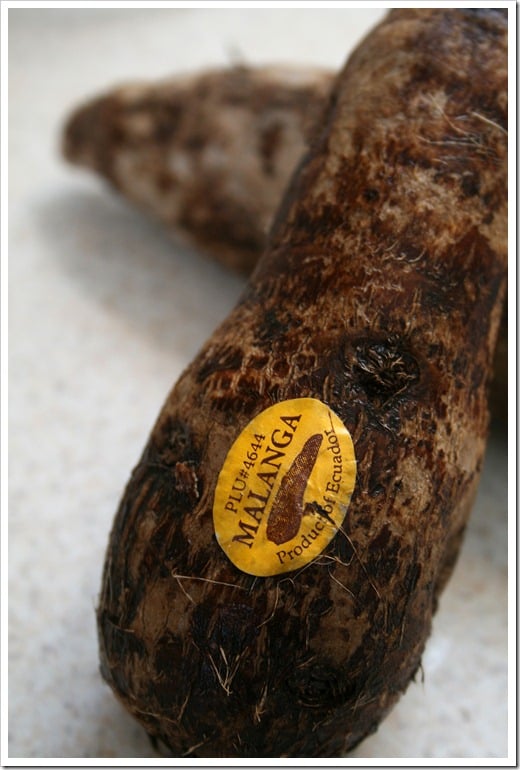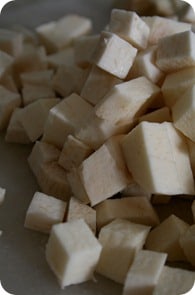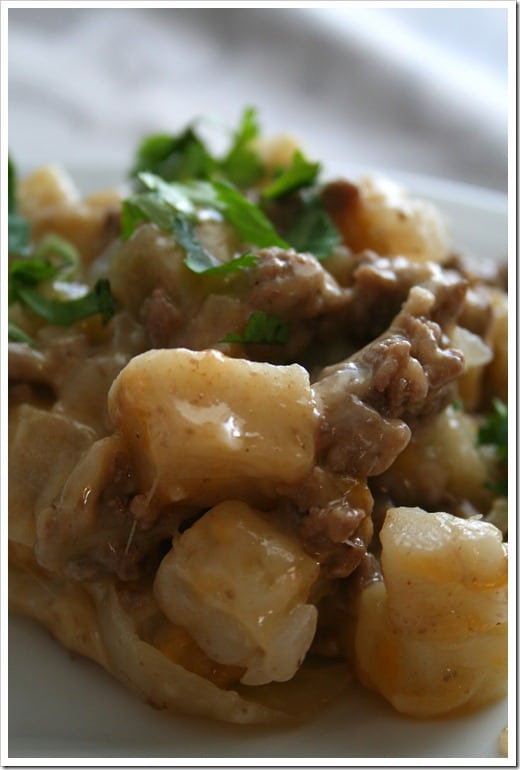What the Helanga is Malanga?
Okay, maybe that isn’t as funny to you as it is to me. But I have a warped sense of humor, and things like that make me giggle. What the helanga is malanga? Hehe.

I wondered this very thing one day when shopping at Food Lion. Now, I live in Podunk, which is the capitol city of Nowhere. Actually, it’s in East Jesus Nowhere, but that’s just the formal name. What I’m trying to say is, I was astounded to see a thing such as Malanga in my local Food Lion. But there it was. So what the heck, I thought. Looks kind of like a scary potato. How bad can it be?
Once I got home, I of course Googled it. Here’s what I learned, from WiseGeek:
Malanga is a brown, hairy tuber in the Arum family which is cultivated in many tropical regions around the world. It is closely related to taro, although the two plants are found in different genera. Like taro, malanga is usually ground into a paste which can be used to make a rich, starchy flour which can be used in an assortment of foods. People with food allergies sometimes find that malanga is a great hypoallergenic flour alternative, because the particles of starch are very small, reducing the risk of an allergic reaction.
Technically, malanga roots are corms, meaning that they are not roots, but rather underground stems which are used to store valuable nutrients for the parent plant. This makes malanga extremely valuable nutritionally, since it contains concentrated nutrition. At first glance, the corms of of malanga plant look sort of like hirsute yams, with dark brown to orangeish skin covered in wiry hair. When split open, the corms have creamy white flesh.
Consumers of malanga describe the flavor as nutty and very earthy. Some people say that it tastes more like an nut than a vegetable. In addition to being ground up for flour, the corms can also be sliced and fried, stewed, or grilled. The leaves are also used as a source of roughage, appearing in stews and on other dishes when they are still young and tender.
See? Just like I said. A scary potato.
 I tasted a bit of it, as I diced it into large cubes. Kind of tastes like…a scary potato. Earthy, more potent than raw potato. Dirty? I wouldn’t have used the word nutty, like the others did, but maybe. Maybe a weird nut that tastes like a scary potato. But still – looked a lot like a potato once cut up, which lessened the scary factor, and I felt like with enough cheese, anything is possible.
I tasted a bit of it, as I diced it into large cubes. Kind of tastes like…a scary potato. Earthy, more potent than raw potato. Dirty? I wouldn’t have used the word nutty, like the others did, but maybe. Maybe a weird nut that tastes like a scary potato. But still – looked a lot like a potato once cut up, which lessened the scary factor, and I felt like with enough cheese, anything is possible.
I proceeded to boil the malanga, just as I would have a batch of potatoes. I cut up 2 large ones, which amounted to roughly 4 medium sized baking potatoes. Enough for a meal for 4 people. I cooked it until the malanga was tender, again, the same as a potato. Then I drained it.
In the meantime, I browned a pound of hamburger, and added diced onions to it, along with garlic, some Lea & Perrins, a little salt, and pepper. Once it was done, I added in the cooked malanga, gave it a good stir, then added 2 cup of grated cheese, a little heavy cream, and some fresh cilantro. Cheese and cilantro on an old shoe would taste good, so, when in doubt, add it.

What resulted was a very respectable dinner! Earthy, yes, but not so much that if you gave it to an unsuspecting diner, they would think it were anything other than potatoes. Seven ate it up, so that’s another bonus – anytime a three year old will consume something, it must be decent. I also liked the consistency of the malanga…it seemed to hold up a little better than a potato.
Most of all, I was pleased that I experimented with an unusual ingredient. it feels rewarding to be able to try something new, and be successful with it. Even if it is a scary bunch of potatoes.
Have a great weekend everyone, and try something new while you’re at it!!






